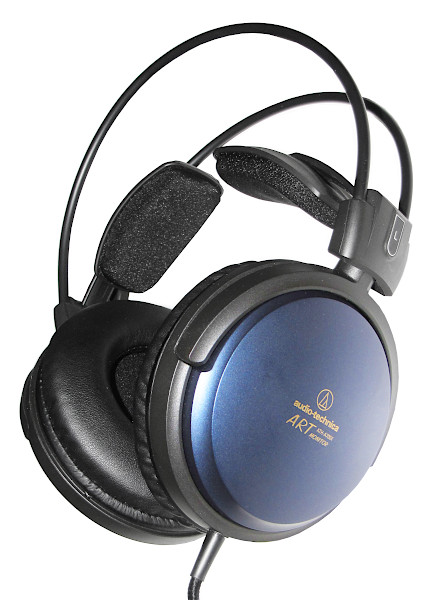ATH-A700X
back to audio-technica
back to measurements
home
published: Feb-02-2022
NO SMOOTHING is applied to the shown plots. Most measurement sites have some smoothing applied which ‘irons flat’ sharp peaks and ‘wiggles’. I do not use smoothing because some info about sound quality is lost when plots are smoothed.
Aside from a small correction of the microphone itself also some correction in the lowest frequencies is applied to the plots to compensate for the perceived loss of bass when using headphones. This is described HERE in more detail.
A ‘horizontal‘ frequency response curve on the shown frequency response plots on this website thus indicates a perceived ‘flat’ tonal signature.
ALL measurements are made with a good SEAL on a flatbed measurement rig.
The shape of your head, bone structure, pad size, pad ‘softness, (compliance), hair or no hair and or wearing glasses may (drastically) change the frequency response of some headphones, so… your personal experience may differ substantially from these plots.
Frequency response (tonal balance) is the most sound-determining aspect of headphones. A horizontal line shows audible neutral response in the plots on this website. Deviations in different severity at different frequency bands have an effect on the sound character.
The bigger the deviation the stronger the effect.
Below an aid to help determining the sound character of headphones with relation to the frequency response.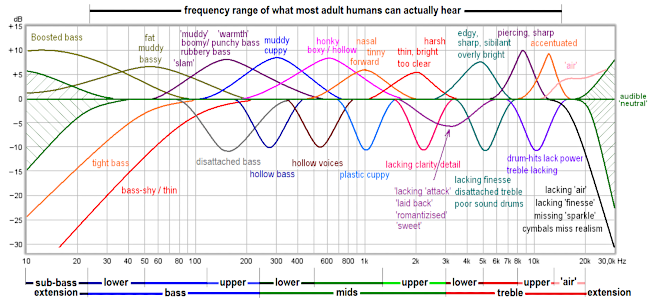
audio-technica ATH-A700X
The audio-technica ATH-A700X is a closed over-ear headphone. When this headphone came out (around 2014 as successor of the ATH-A700) the MSRP was around € 250.- It was only made for a couple of years before being discontinued.
The 3m cloth covered cable is mildly microphonic so in quiet passages and silences the cable rubbing against clothes are audible in the left cup. The cable is fixed so cannot be replaced.
This headphone does not have the usual headband as seen in most headphones. The ATH-A700X uses the ‘wing type’ headrests that do not sit on top of the head but rest against the sides of the head.
This takes some getting used to and kind-of works.
The pleather pads are changeable and feel soft to the touch. After a while they feel sweaty and warm. There is ‘normal’ foam inside the pads. The weirdest thing about these pads is the integrated dust filter. This makes the pad depth just 16mm. There is plenty of ‘room’ left below the dust filter as the drivers are angled substantially. Just below the dust filter there is some foam around the driver so when the ears do touch the headphone at least there is no direct contact with plastic.
Making the space around the driver a little bigger and making a different dust filter would have been better.
It is a closed headphone and outside noises are somewhat attenuated. Of course this also works the other way around so while listening to music those around you will not be bothered.
With a sensitivity of 119dB/V (efficiency = 104dB/mW) and low impedance (35 Ω measured) this headphone plays very loud even directly from a phone.
This reviewed (and repaired) audio-technica ATH-A700X is for sale.
specifications:
Type: Over ear (circum-aural), closed
Usage: Home, portable
Driver type: dynamic
Pads: replaceable, pleather, regular foam
Collapsible: no
Headphone cup connector: fixed
Cable entry: single sided (left).
Cable: 3m cloth covered in a gold-plated 3.5mm TRS jack with a 6.3mm adapter.
Inner Pad dimensions: depth = 16mm, diameter = 51mm.
Driver size: 53mm (angled 20°) effective diameter = 48mm
Nom. power rating: 500mW (0.5W)
Max. voltage: 4.2Vrms (12Vpp)
Max. current: 120mA
Max. S.P.L.: 130 dB
Impedance: 35 Ω (measured)
Efficiency: 104dB @ 1mW
Sensitivity: 119dB @ 1V
Weight: 306 g. (without cable)
Clamping force: medium (5N)
Accessories: 6.3mm adapter
Subjective sound description:
Bass is present and slightly elevated and boomy/muddy.
Mids have a ‘hollow’ sound to it and lack clarity.
Treble is accentuated and have a sharpness to it.
When the accentuated lows are reduced the headphone has an ethereal sound.
Stereo image, despite the substantially angled drivers and ear-driver distance is not wide/spacious.
Measurements:
Below the frequency response of the ATH-A700X (Left, Right) with a perfect seal (headphone pressed a bit to the fixture)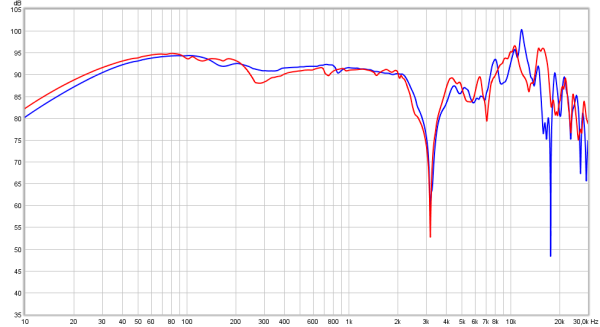 The channel matching is decent. Bass extends well but is elevated about 5dB between 50Hz and 200Hz.
The channel matching is decent. Bass extends well but is elevated about 5dB between 50Hz and 200Hz.
This makes the bass a bit elevated and boomy and muddy. From 200Hz to 2kHz the response is pretty neutral. The dip between 2kHz and 4kHz is 10dB deep and quite audible and makes the sound a bit ‘weird’. The sharp dip is actually a resonance and only appears that deep as evidenced by the CSD of the left channel (below). Above 7kHz the treble starts to peak. At 12kHz it even reaches +10dB. This is responsible for the sharp (fake detail) sound of the treble. For people over 60 this treble peak won’t be audible and might even be an advantage. Treble is well extended beyond 20kHz.
Above 7kHz the treble starts to peak. At 12kHz it even reaches +10dB. This is responsible for the sharp (fake detail) sound of the treble. For people over 60 this treble peak won’t be audible and might even be an advantage. Treble is well extended beyond 20kHz.
phase response
Below the phase response of the ATH-A700X (Left, Right)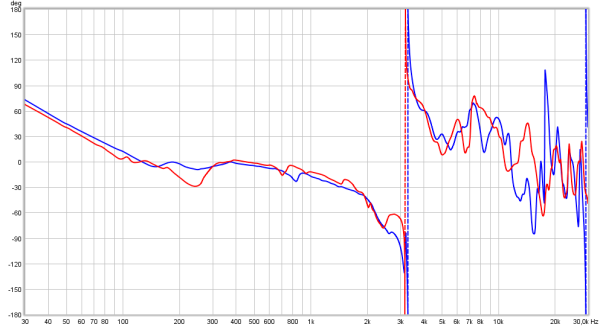 Slow phase shifts are not very audible. Sharp changes in a narrow frequency bands may well be audible. The sharp shifts at 2kHz are audible and also responsible for the perceived weird sound quality of the mids.
Slow phase shifts are not very audible. Sharp changes in a narrow frequency bands may well be audible. The sharp shifts at 2kHz are audible and also responsible for the perceived weird sound quality of the mids.
output resistance / damping-factor
As this is a dynamic headphone the frequency response can be amplifier output resistance dependent when certain higher output resistance amplifiers are used.
Instead of showing impedance plots, which are hard to ‘read’ when it comes to assessing the tonal balance change in the real world, the ATH-A700X is measured via a few different resistance outputs (0.2Ω, 10Ω, 32Ω and 120Ω). On a higher output resistance amplifier the output level will be lower of course due to voltage division. To compensate for this the amplifier is cranked up to the same level (11.7dB for 120Ω at 1kHz in this case). This way the plots are overlaid and it is easier to see how the tonal balance changes. Output resistances between the mentioned resistance values will result in tonal changes between those traces.
Note: the measurement is made with a normal seal, so not lightly pressed onto the test fixture.
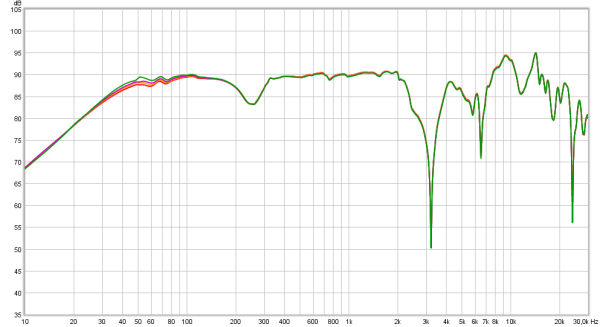
The tonal balance in the bass does not really change when a higher output resistance amplifier is used.
This headphone thus can be driven from just about any amp without a change in tonality.
seal
Seal can be an issue with closed-back headphones. Breaking the seal (improper fit on the head) usually means a loss of (sub)bass. This can be caused by hair or glasses between head and pad or head shape.
Normal seal, seal broken with hair, seal broken with thick armed glasses flush with the skin, seal broken by thicker armed glasses that create some space between the pad and skin.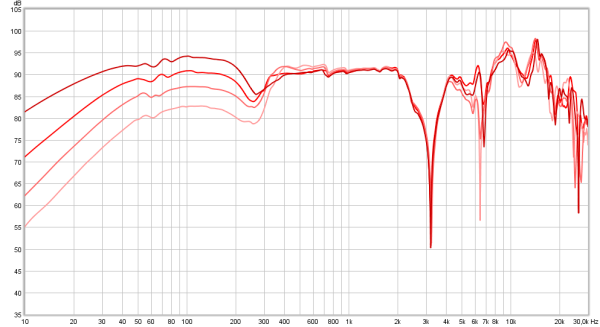 A broken seal has definitely influence on the tonality of this headphone. A small seal breach is a good thing but wearing thick armed glasses already changes the tonal balance. The contact area with the skin is wide but the pads are a bit too ‘firm’ to create a good seal.
A broken seal has definitely influence on the tonality of this headphone. A small seal breach is a good thing but wearing thick armed glasses already changes the tonal balance. The contact area with the skin is wide but the pads are a bit too ‘firm’ to create a good seal.
Below the distortion measurements of the ATH-A700X (Right channel). The measurements are made at 90dB SPL.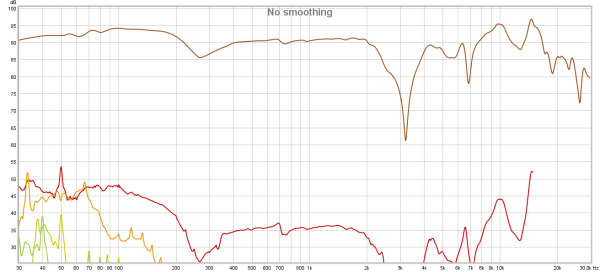 The plot above shows the level differences between the signal (upper trace) and the harmonics.
The plot above shows the level differences between the signal (upper trace) and the harmonics.
Most people prefer to see percentages instead of level differences so below the exact same plot except ‘normalized’ to the actual signal and level differences given in percentages.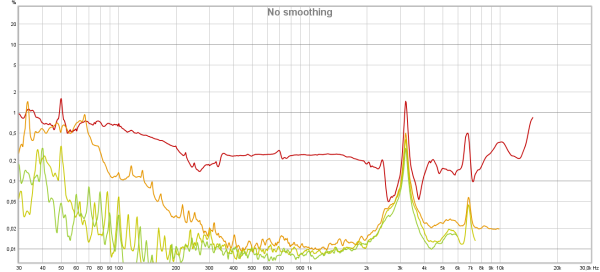 Distortion levels at 90dB SPL are not very high for a 53mm driver. Below 100Hz there is some 3rd harmonic distortion and reaches an almost audible 1% below 60Hz.
Distortion levels at 90dB SPL are not very high for a 53mm driver. Below 100Hz there is some 3rd harmonic distortion and reaches an almost audible 1% below 60Hz.
2nd harmonic distortion above 100Hz is below 0.5%. Above 200Hz distortion is quite low. The peak at 3kHz is not really there but caused by the sharp dip which acts as the reference so the ‘distance’ between the reference (frequency response at that frequency) is smaller leading to a higher number only (see the upper distortion plot).
The actual 2nd harmonic distortion above 1kHz may well be lower than 0.2% . A shortcoming of my measurement rig.
The left channel of this (2nd hand) headphone has an issue though. The distortion levels are considerably higher and is even audible. The (faulty) left channel is shown below.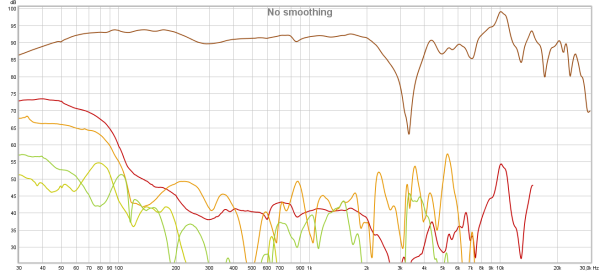 The membrane seems to flex strangely when presented with frequencies below 150Hz.
The membrane seems to flex strangely when presented with frequencies below 150Hz.
A ‘ratteling’ sound occurs at that moment. With some music this seems to be masked a bit (due to harmonics being present) so isn’t always very audible.
Below the CSD (waterfall) plot of the ATH-A700X. (Left and Right are overlaid) The big driver appears to have quite a few resonances at various frequencies and does not appear to be well behaved.
The big driver appears to have quite a few resonances at various frequencies and does not appear to be well behaved.
Below the Group Delay plot for the ATH-A700X (Left, Right)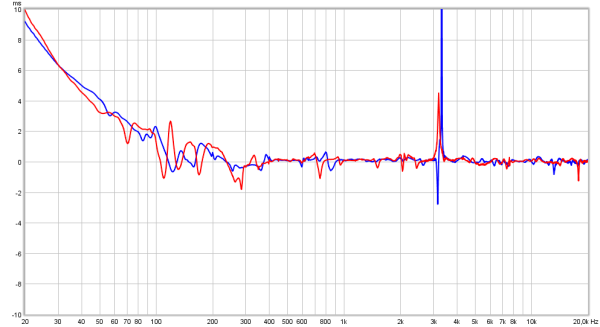
At 100Hz there is some small ‘pad bounce’. The many small peaks and dips and the large one at 3kHz all indicate the driver has lots of small resonances over the entire audible band. The one at 3kHz is by far the biggest one.
A different plot is the spectrum plot. This basically is a CSD (Waterfall) plot but viewed from above where the level differences are color coded instead of being in the vertical axis. Also the frequency range of the spectrum plot is wider (from 100Hz instead of 500Hz). The time span is also bigger in the spectrum plots and expired time is shown from below to top where in the CSD the time is shown from rear to front.
Below the spectrum plot of the ATH-A700X (Right channel) 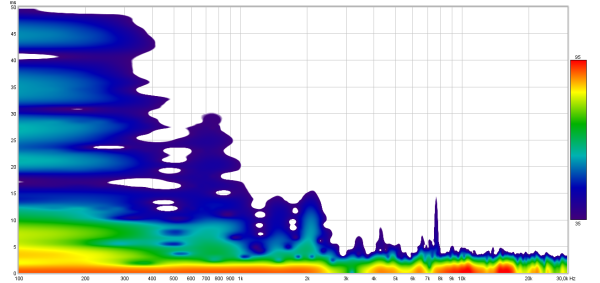 Here too the various resonances are easily spotted. The ones below 2kHz can color the sound.
Here too the various resonances are easily spotted. The ones below 2kHz can color the sound.
Step response
Below the step response plot which, when the sound is balanced and well extended should show a fast rise to around 0dB, (indicating fast driver response) and then should be slightly sloping downwards indicating bass extension. (Left, Right)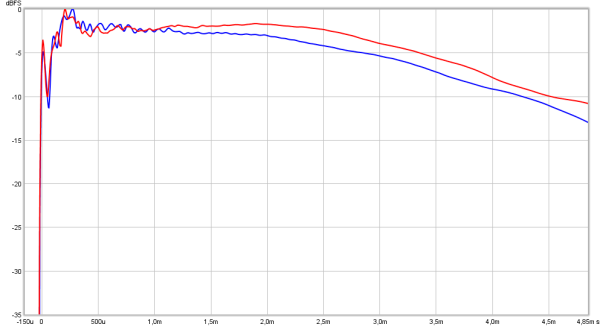 Note: this plot is based on the frequency response measurement where the pads are slightly pressed onto the fixture.
Note: this plot is based on the frequency response measurement where the pads are slightly pressed onto the fixture.
treble filter
As with a lot of audio technica models in this series a signature sound (a bit like Beyer and Grado for instance) is to have a treble peak. Fortunately this peak is not in the sibilance area (5-7kHz) but around 10kHz. This can create the illusion of hyper detail but when overdone it can turn into ‘sharpness’.
The filter below removes the sharpness and turns the ‘not natural’ hyper detail into fine detail.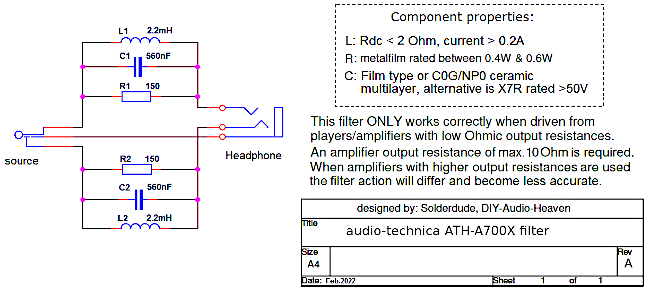 Below the effect this filter has on the frequency response, stock vs filtered.
Below the effect this filter has on the frequency response, stock vs filtered. The sharpness is no longer there and replaced by a very smooth and detailed treble.
The sharpness is no longer there and replaced by a very smooth and detailed treble.
conclusion
The ATH-A700X is not a neutral headphone. It has a distinct tonal balance. With a good seal the bass is a bit muddy but a small seal leakage is enough to make it sound a bit better in the lows.
The sound is a bit ‘off’ in the mids and has a weird sound to it. This is caused by the substantial dip in the 3kHz region. Treble is a bit emphasized and can have sharpness to it depending on the recording.
That sharpness can also be perceived as ‘highly detailed’ sound.
This headphone can be driven directly from portable equipment, no need for powerful amplifiers.
It can also be used from receivers (old and new) that have a headphone out connector.
As the cable is fixed and has a 3.5mm TRS jack the ATH-A700X cannot be used from balanced amps.
The 3m long and somewhat stiff cloth covered cable suggests home usage. When using it portable one would have to do something about the long cable.
The wing system works different than normal headbands and may not work equally well for anyone. This will depend on head shape and size.
There are better sounding closed headphones in this price class.
A similar headphone in the current (2022) line will be either the ATH-A550Z or the ATH-A990Z.

